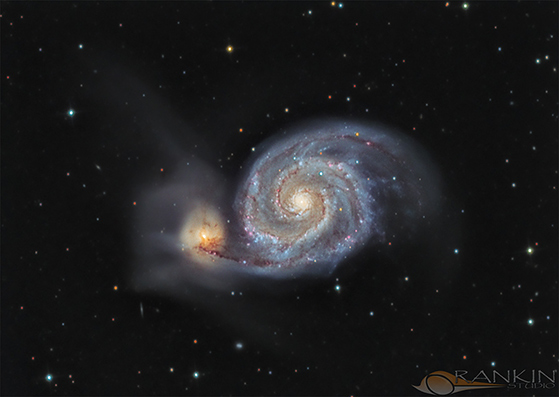The Whirlpool Galaxy, or M51, is a massive spiral type galaxy that is positioned beautifully face-on near The Big Dipper in the constellation Canes Venatici.
It is about 24 million light years away and part of a cluster of gravitationally bound galaxies called … wait for it … the M51 group.
Messier 51 was discovered on October 13, 1773 by Charles Messier. Charles was a famous comet hunter, and on his quest to find the icy space balls he put together a very nice catalog of objects he came across that were not comets. This one made it into his catalog as Messier 51 later to be dubbed “The Whirlpool Galaxy” for obvious reasons. The catalog Charles put together is still widely used today.
The Whirlpool Galaxy, (Messier 51)

You may be sitting there thinking, “Who is this guy and why is he claiming he took this photograph?” You may think this kind of photograph is only possible if you work for NASA and have a telescope orbiting about in space. Surely there is no way some random guy in his back yard can do such things.
Let me tell you, it is not easy. This has by far been the most frustrating, hair pulling, expensive, sleep depriving, time consuming, overwhelmingly rewarding hobby, I have ever gotten into. There are so many things that can go awry when attempting to create a photograph like this one.
So how is it done?
First and foremost, to get an image of this depth—the faint dust strewn about between the galaxies, the small galaxies tossed about in the background—requires a very dark sky. Fortunately I live out in Southern Utah, and if there is one thing we have a lot of here other than lizards, sand, and canyons, it is dark skies. On a new moon the skies out here are some of the darkest left in the country. When you are in a city, the night sky gets drown out by light pollution. All of the artificial lighting is bouncing around in the atmosphere and creating a very nasty yellow orange glow. This really puts a damper on pursuing astronomy as a hobby. It also disconnects us from the universe. Visit www.darksky.org to learn more about light pollution.
If you have a dark location, you then need to invest in equipment for astrophotography. This can break the bank for sure. I have gotten by over the years using cheap equipment and upgrading when I could. I can say now that I have a very nice mid-range astrophotography setup.
Basically I am attaching a camera to the telescope where you would normally look through it, then taking long exposures. If you think about “exposure” as an empty cup being filled with light, it is easy to understand why a camera can see so much more than the human eye. The human eye has a light sensor, just like a camera has an image sensor. The light coming in that is captured by these sensors is the exposure. In the case of our vision, the light hits our retina and our brain captures about 30 images every second which we perceive as seeing in “real time”. So in effect, our brain is filling up and emptying out the “exposure cup” 30 times every second. This really limits the overall amount of light we can capture with our eyes. A camera on the other hand does not have this problem. Its cup can sit and collect light for hours. So when you look at the galaxy above through a telescope on a dark night with your eye, you may see a fuzzy white patch along with a little bit of the spiral shape. If you stick a camera on the telescope, it will sit there and drink up all of the light coming from the galaxy creating the beautiful image you see above. Digital cameras are an amazing invention, in a way they are an extension of our own senses, created by human kind to help us experience more of the universe than our limited senses ever could.
The next problem you run into is the rotation of the earth. These images are zoomed in and it would take less than a second for the stars to streak when taking a photograph just from earth’s rotation. This motion is counteracted by the telescope mount. It is designed to rotate the opposite direction the earth rotates so you can keep an object stationary in the camera view.

From there, some complicated capturing and processing techniques gets you to the image above.
You don’t have to take out a second mortgage to enjoy astronomy. There are many sites where images are posted for free to enjoy. You can invest in a smaller telescope for visual use on the planets and some of the brighter nebulae easily spotted in the night sky for a few hundred bucks. Most communities have astronomy clubs that will regularly host star parties which are open to the public. The people in these clubs are a different breed. They are dedicated and more than willing to share the wealth of information they have about equipment and astronomy in general. If you have the curious twinge I did, I recommend seeking out one of these clubs as a good starting point.
